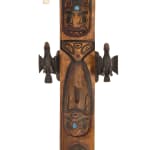-
Artworks
UNIDENTIFIED ARTIST, HEILTSUK
Monumental Model Totem Pole, early 20th centurymounted on a bentwood box-style base, early 20th century,
wood, pigment, abalone, and metal, 81 x 18.5 x 8 in (205.7 x 47 x 20.3 cm).
LOT 74
ESTIMATE: $30,000 — $45,000
PRICE REALIZED: $45,600.00Further images
-
(View a larger image of thumbnail 1
)

-
(View a larger image of thumbnail 2
)

-
(View a larger image of thumbnail 3
)

-
(View a larger image of thumbnail 4
)

-
(View a larger image of thumbnail 5
)

-
(View a larger image of thumbnail 6
)

-
(View a larger image of thumbnail 7
)

-
(View a larger image of thumbnail 8
)

-
(View a larger image of thumbnail 9
)

Monumental scale is only one of the unusual characteristics encountered in this very out-of-the-ordinary model totem pole. To that feature one could add the four birds attached to the sides...Monumental scale is only one of the unusual characteristics encountered in this very out-of-the-ordinary model totem pole. To that feature one could add the four birds attached to the sides (two bald eagles, two ravens), the curious cant of the added-on eagle head at the top, the use of inlaid embellishment and the box that forms the base of the pole. Other figures that appear are two whales and a raven at the bottom. The splayed humanoid figure on the box front is reminiscent of similar images often seen in house front and interior house screen paintings.
Documented to the Heiltsuk, this pole is the work of a self-taught artist with a strong personal vision of his goal. The design and sculptural work differ from historical Heiltsuk art traditions, but this monument was carved in the transitional years of the early twentieth century, when few examples of historical artworks to serve as guides remained in the villages, due to the efforts of missionaries and various colonial forces. The artist has reproduced elements from the formline tradition and applied them where they would traditionally have been used, but not always within the kinds of design structures employed by artists of an earlier period. The wings and tail of the top eagle, the fins and tail of the two whales and the raven’s wings at the bottom reflect the general character of more traditional design work, and the eagle’s head at the top bears a strong relationship with historical Heiltsuk mask-sculpture, though it varies from the usual adaptations of sculpture in the totemic traditions.
The pole may have been originally created in association with the funeral of a respected clan or family leader, suggested by the box at the base, which is the traditional reason for the creation of historic-period monuments of this type. Later sale may have brought it to the collector’s market.
Steven C. Brown
Literature: For an eight-sided plaque with an eagle (collection of UBCMOA), that bears a strong resemblance to the top of this pole, see Martha Black, Bella Bella: A Season of Heiltsuk Art (Toronto: Royal Ontario Museum / Vancouver: Douglas & McIntyre, 1997), fig. 19. The plaque was collected by Dr. George Darby at Bella Bella, probably in the 1920s. Black also illustrates another similar plaque (ROM, accessioned 1902) as well as a painted grave house front with a similar projecting eagle’s head (ibid., pp. 85-88).Provenance
Private Collection, France;
A Canadian Collection.
-
(View a larger image of thumbnail 1
)
Join our mailing list
* denotes required fields
We will process the personal data you have supplied in accordance with our privacy policy (available on request). You can unsubscribe or change your preferences at any time by clicking the link in our emails.









